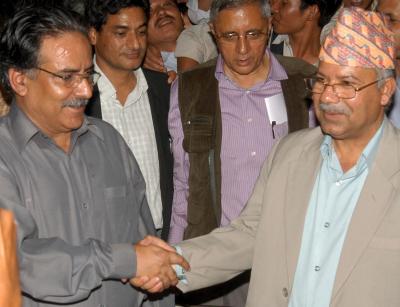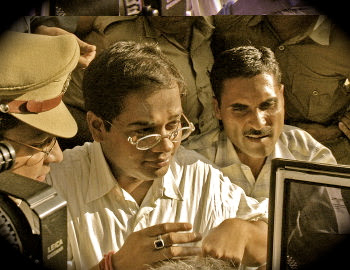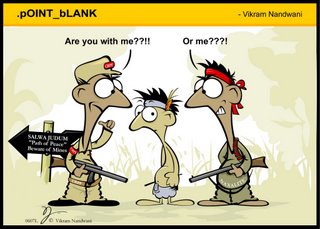
Note: The following was translated into Hindi, and published by the newspaper ‘Chhattisgarh’ (26.06.2006).
Once I got through the drill of downloading the hindi font and re-encoding the text, I couldn't help feeling somewhat vindicated reading
Shubranshu’s article (published in Daily Chhattisgarh as column ‘Basee Ma Ufaan’ on 23 June 2006).
However as a student of realpolitik, I also realize that the adage 'jo jeeta wohi sikandar' (winner takes all) holds.
Letting Mr Advani depute 157 CRPF and other paramilitary companies in Chhattisgarh's 25 'affected' constituencies- and then allowing them to remain mobile on active field-duty (rather than being kept as 'reserves' at district headquarters, as in Dantewada district where Congress won all three seats)- under the direct supervision of his two MoSs- Mr ID Swami and Swami Chinmayanand, both of whom were stationed in Bastar and Ambikapur respectively- was an open invitation to Disaster. In retrospect, any blind man could have seen what was coming. My father, for some reason, didn't.
Confirmation of what really happened came soon after election results were announced: the IGP Bastar, who oversaw central reserve forces deployment, was transferred as IGP Raipur the very next day, where he subsequently oversaw the reopening of the Jaggi case. Not many months later, he was promoted, out-of-turn ofcourse, to ADGP. Curiously, he is now overseeing counter-naxal operations. [Rahul's comment about] the BJP 'landslide' in rest of Chhattisgarh- or more specifically the Mahanadi basin (central Chhattisgarh)- is unmerited as the Congress won 33 of the 56 seats here (up from 24 in VS-1998). Furthermore, the polling percentage of 77% registered during VS-2003 elections at Bastar remains unmatched to this date: during the 2005 Panchayat elections (swept by the Congress), when polling is expected to be highest given intense local participation, only 51% of the electorate turned out to vote. Moreover, polling percentages in the 'affected' areas were significantly higher than in the non-affected areas of ‘Old Bastar’. To give a specific example, votes cast at the Orchha polling station during VS-2003 were 897 (up from 9 in VS-1998). So yes, there is a lot of sense in what has been stated in the article. Papa, along with all Congress candidates from Bastar, was to address a press conference on this issue on the very next day Mr Jaitley released his 'tape' (cash-for-MLAs scam). Naturally, that didn't happen.
As far as the Naxalites are concerned, I don't think it really matters to them who comes to power in the state: frankly, what they want- a separate Dandkaranya no less- deals directly with the first of what Pt. Nehru termed India's 'non-negotiables': the territorial integrity and political sovereignty of the nation. I don't see the Union agreeing to this particular utopian demand anytime soon. The state, on the other hand, is simply not authorized to talk on such subjects even though this Governor had made something of a show of visiting jails to hold impromptu discussions with LWE inmates. But if they are willing to emulate the Prachanda example [the hitherto elusive Maoist leader who recently joined Mr. Koirala’s national government in Nepal], then yes, there is Hope. I have stated as much in my prison diary entry (posted here elsewhere) when I spoke of 'cooption'- a formula that has worked in the past, though informally ofcourse. We could try it first at the level of local self-government before confidence can be instilled in both sides for taking it to the levels of state and national governance. I am told that while Indian-Maoist cadres are keen, the leadership isn't. That may change, if governments bring something more to the negotiating table. Sadly, political will- and insight- to do so is lacking.
This state government is only too aware of the role paramilitary forces have played in its coming to power: by ensuring that more and more areas become classified as 'affected' it hopes to repeat VS-2003 in VS-2008. And as long as the Naxalites remain mute spectators- boycotting elections because they don't believe in them- there isn't a thing they can do about it. And all hope for a Prachanda-like political solution will remain just that: a wasted opportunity to put an end to a senseless violence that has already claimed too many good lives.
Read More (आगे और पढ़ें)......







